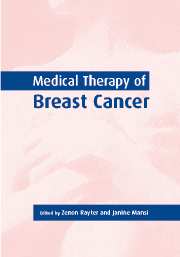Book contents
- Frontmatter
- Contents
- List of contributors
- 1 History of breast cancer therapy
- 2 Chemoprevention of breast cancer
- 3 Familial breast cancer
- 4 Hormone replacement therapy and breast cancer
- 5 Screening for breast cancer
- 6 The management of in situ breast cancer
- 7 Adjuvant systemic therapy
- 8 Adjuvant radiotherapy in the management of breast cancer
- 9 Predictors of response and resistance to medical therapy
- 10 Primary medical therapy in breast cancer
- 11 Medical therapy of advanced disease
- 12 Experimental approaches
- 13 The place of bisphosphonates in the management of breast cancer
- 14 Palliative care in breast cancer
- Index
6 - The management of in situ breast cancer
Published online by Cambridge University Press: 06 January 2010
- Frontmatter
- Contents
- List of contributors
- 1 History of breast cancer therapy
- 2 Chemoprevention of breast cancer
- 3 Familial breast cancer
- 4 Hormone replacement therapy and breast cancer
- 5 Screening for breast cancer
- 6 The management of in situ breast cancer
- 7 Adjuvant systemic therapy
- 8 Adjuvant radiotherapy in the management of breast cancer
- 9 Predictors of response and resistance to medical therapy
- 10 Primary medical therapy in breast cancer
- 11 Medical therapy of advanced disease
- 12 Experimental approaches
- 13 The place of bisphosphonates in the management of breast cancer
- 14 Palliative care in breast cancer
- Index
Summary
Introduction
Ductal carcinoma in situ (DCIS) is defined as a proliferation of epithelial cells with cytological features of malignancy within parenchymal structures of the breast and distinguished from invasive carcinoma by the absence of stromal invasion across the basement membrane (National Co-ordinating Committee on Breast Screening Pathology (NCCBSP), 1995). It is conventionally regarded as the principal precursor of breast cancer and is distinct from lobular carcinoma in situ (LCIS), which is now regarded as a high-risk factor for the subsequent development of invasive breast cancer rather than a precursor lesion (Poller & Ellis, 1996).
DCIS of the breast has become an increasingly important pathological entity in the last 15 years with an approximately fourfold increase in incidence in the USA compared with only a modest rise in the incidence of invasive disease (Hankey et al., 1993). This is due mostly to the introduction of screening mammography but may also be due to the increased recognition of DCIS by breast pathologists (Frykberg & Bland, 1994). The incidence of symptomatic DCIS (as opposed to screen-detected DCIS) has not increased significantly and usually presents clinically as a palpable mass, Paget's disease or with nipple discharge and comprises 3–5% of symptomatic cases (Ashikari et al., 1971; Lagios, 1990). In the United Kingdom, there were 1308 cases of DCIS recorded by the National Breast Screening programme for the year 1994/95, accounting for 25.2% of breast cancer cases in the screened population aged 50–64 (Julietta Patnick, personal communication).
- Type
- Chapter
- Information
- Medical Therapy of Breast Cancer , pp. 126 - 152Publisher: Cambridge University PressPrint publication year: 2003



